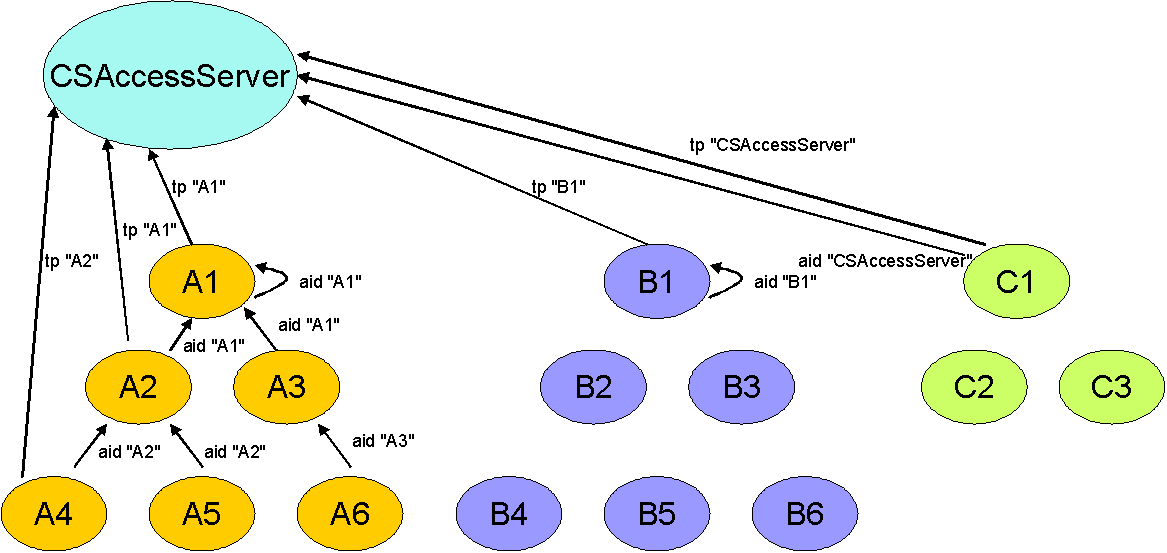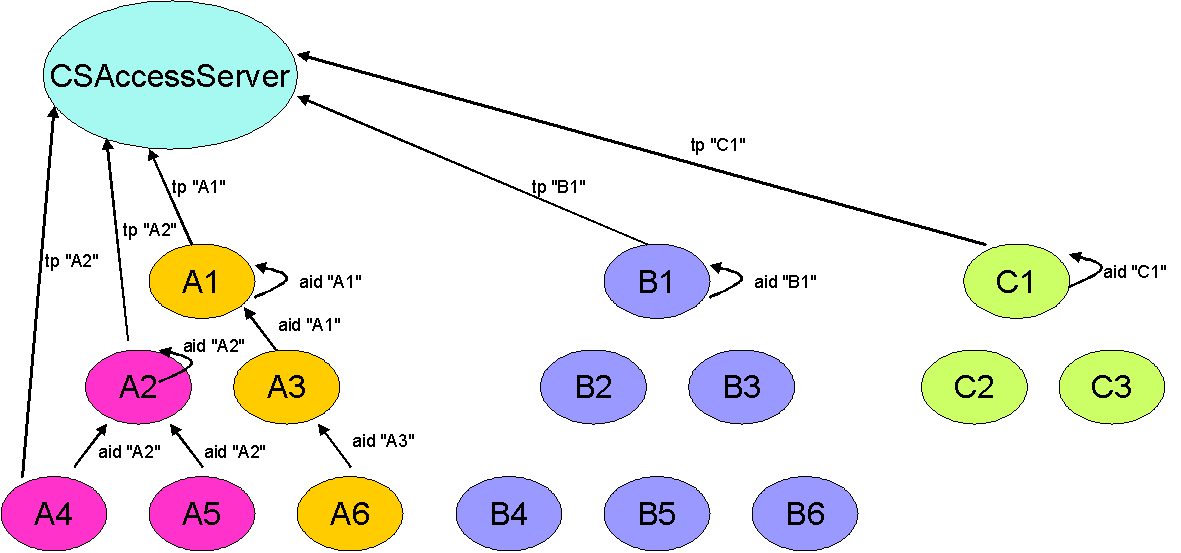You are here: GSI Wiki>CSframework Web>CSSubProjects>CSAccessSystem (2009-08-25, DietrichBeck)Edit Attach
CS Access System
Introduction
The CS Access System (CAS) provides the possibility to lock (and unlock) objects or sub-systems for exclusive use. As an example, if an object or a sub-system is locked via a GUI, the object or sub-system will only accept events from that GUI but will no longer accept events from other GUIs. CAS based on a very simple mechanism and not intended to prevent malicious attacks. CAS is meant to prevent simultaneous and accidential access of shared resources from different parts of a distributed control system. A typical use-case are two operators (A, B) sitting at different consoles trying to change the setting of the same power supply without knowing about each other. In such a case, operator A can lock the power supply. The object representing the power supply will only except events from the GUI of operator A, but operator B can not operate the power supply from his GUI. CAS has been written in LabVIEW and licensed under the GNU Public License (GPL).Principle
CAS is based on a publisher-subscriber mechanism. This mechanism is implemented via a dedicated thread for each object and a CSAccessServer.- For locking and unlocking, objects form a hierarchical tree. Each hierarchical tree can be called a sub-system. A sub-system must consist of at least one object.
- Each object has a so-called AccessID.
- When sending an event, each object sends its AccessID together with the event data.
- When receiving an event, an object only accepts the event data, if its own AccessID matches the AccessID coming with the event data.
- For each object, the CSAccessServer publishes the name of the parent object of that object.
- Each object subscribes to the CSAccessServer to obtain the name of its parent object.
- Each object publishes its own AccessID.
- Each object subscribes to the AccessID of its parent object.
- The CSAccessServer is the generic top object for all objects.
- If an object is not locked, any other object can become the parent object of that object via the CSAccessServer.
- All object within a sub-system inherit the AccessID of the top object of that sub-system.
- Every object in a sub-system can send an event to all objects within the same sub-system.
- If a sub-system is not locked,
- the top object of that sub-system is the CSAccessServer.
- all objects on the network can send events to every object of that sub-system.
- If a sub-system is locked,
- the top object of that sub-system is an object, that is its own parent object.
- only objects within the sub-system can send events to other objects of that sub-system
- Locking a sub-system only requires to lock the (previous) parent object of a sub-system.
- Locking and unlocking of sub-system can be done on-the-fly.
- Partitioning and re-partitioning can be done on-the-fly.
- The configuration of the default parents of all object within the CSAccessServer
- is important,
- should be static and can be saved/reloaded to/from files,
- should not be accessible to normal users.
Example
 The figure above shows a control system with three sub-systems, "A", "B" and "C". For each object, the CSAccessServer publishes the name of the tree parent. This is shown for the objects "A1", "A2", "A4", "B1" and "C1". Here, the two sub-system "A" and "B" are locked. Sub-System "C" is not really a sub-system, since its tree parent is the CSAccessServer. Therefore, sub-system "C" is not locked. Any object in sub-system "A" can send an event to any other object in sub-system "A". As an example, object "A1" may send an event to object "A6" and object "A6" may send an event to object "A1". Same for sub-system "B", where all objects of "B" can communicate with each other. However, sub-system "C" is not locked. So any object of sub-systems "A" and "B" may send events to any object of sub-system "C".
The figure above shows a control system with three sub-systems, "A", "B" and "C". For each object, the CSAccessServer publishes the name of the tree parent. This is shown for the objects "A1", "A2", "A4", "B1" and "C1". Here, the two sub-system "A" and "B" are locked. Sub-System "C" is not really a sub-system, since its tree parent is the CSAccessServer. Therefore, sub-system "C" is not locked. Any object in sub-system "A" can send an event to any other object in sub-system "A". As an example, object "A1" may send an event to object "A6" and object "A6" may send an event to object "A1". Same for sub-system "B", where all objects of "B" can communicate with each other. However, sub-system "C" is not locked. So any object of sub-systems "A" and "B" may send events to any object of sub-system "C".
Locking of a Sub-System
 In the above figure, the CSAccessServer has changed the parent name of object "C1" from "CSAccessServer" to "C1". Now, sub-system "C" is locked. Any object in sub-system "C" will only accept events from objects within the sub-system "C". Objects from sub-systems "A" and "B" can no longer send events to objects of sub-system "C".
In the above figure, the CSAccessServer has changed the parent name of object "C1" from "CSAccessServer" to "C1". Now, sub-system "C" is locked. Any object in sub-system "C" will only accept events from objects within the sub-system "C". Objects from sub-systems "A" and "B" can no longer send events to objects of sub-system "C".
Partitioning
In the second figure, the CSAccessServer has changed the tree parent of object "A2" from "A1" to "A2". The effect in the tree structure is dramatic: The objects "A2", "A4" and "A5" now form an own sub-system "A magenta" which is locked. "A2", "A4" and "A5" can communicate with each other. The remaining objects of the previous sub-system "A" ("A1", "A3" and "A6") can still communicate with each other. The sub-systems "A magenta" and "A" are completely independent like the sub-systems "B" and "C" (In fact, it would be better to draw the sub-system "A magenta" on the same level as the sub-system "A", "B" and "C".) No object of sub-system "A magenta" can communicate with any object of sub-system "A" and vice versa.Download
CAS is already included in the core system of CS, see here. -- DietrichBeck - 18 Jul 2006Edit | Attach | Print version | History: r3 < r2 < r1 | Backlinks | View wiki text | Edit wiki text | More topic actions
Topic revision: r3 - 2009-08-25, DietrichBeck
- User Reference
- BeginnersStartHere
- EditingShorthand
- Macros
- MacrosQuickReference
- FormattedSearch
- QuerySearch
- DocumentGraphics
- SkinBrowser
- InstalledPlugins
- Admin Maintenance
- Reference Manual
- AdminToolsCategory
- InterWikis
- ManagingWebs
- SiteTools
- DefaultPreferences
- WebPreferences
- Categories
 Copyright © by the contributing authors. All material on this collaboration platform is the property of the contributing authors.
Copyright © by the contributing authors. All material on this collaboration platform is the property of the contributing authors. Ideas, requests, problems regarding GSI Wiki? Send feedback | Legal notice | Privacy Policy (german)
